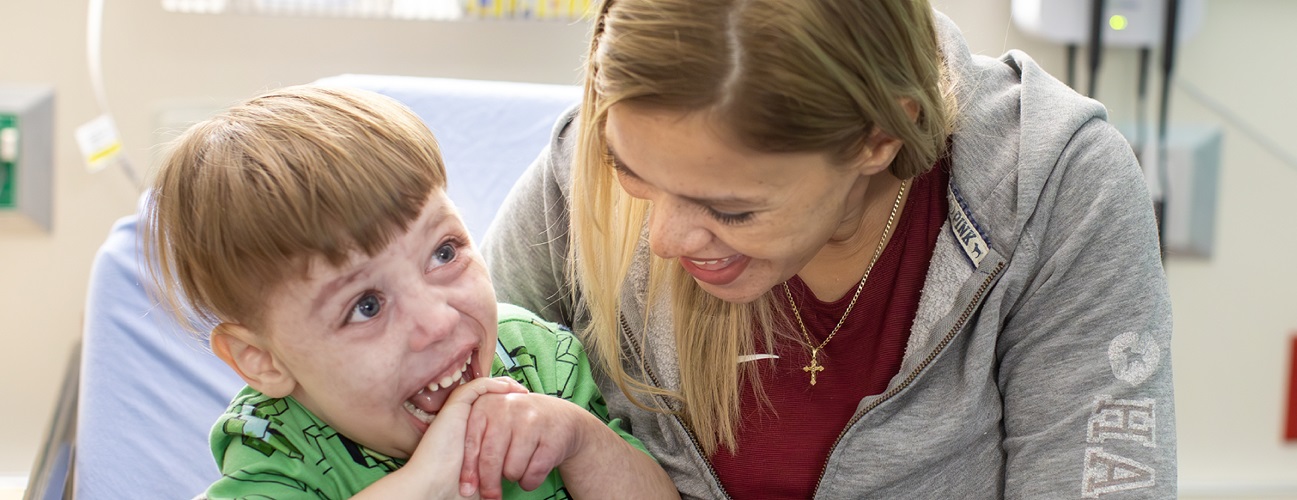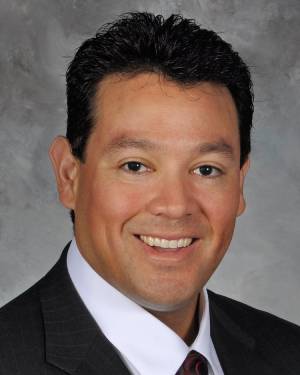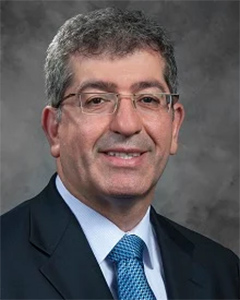Patient Story
Sturge-Weber Syndrome: Knight’s Story
Three-year-old Knight is a joyful ball of energy as he runs in circles from the family’s living room to dining room to kitchen.
He loves this little game, and for most 3-year-olds, this wouldn’t be an extraordinary feat.
But, for this little boy, it is remarkable.
Knight was born with Sturge-Weber Syndrome, a rare genetic mutation that causes exponential abnormal growth of blood vessels in the skin, eyes and brain.
“It’s a very infrequent disease, affecting one in 20,000–50,000 people,” says Tom Geller, M.D., a pediatric neurologist and co-director of the Neurocutaneous Disorders Clinic at Johns Hopkins All Children’s Hospital in St. Petersburg, Florida.
"It’s not inherited from mom or dad,” Geller says. “It occurs in the embryo after fertilization.”
Sturge-Weber Syndrome may be characterized by a purple birthmark on the skin called a port-wine stain. Glaucoma is common with this syndrome, as are seizures. If left untreated, the condition can lead to severe brain damage and can be life-threatening.
For a mother giving birth to her first and only child, it was unfathomable.
Reality Check
Victoria’s healthy pregnancy offered no clues as to her baby’s condition. Even when Knight was born, she says the doctor who delivered him in a Sarasota hospital explained the newborn’s deep purple color as “just some bruising.”
The next day, when an attending pediatrician told her that her baby boy likely had Sturge-Weber Syndrome, she was devastated.
“I was in complete denial, and I was so mad at that doctor,” Victoria says. “I was like, ‘How could you say this? My son just has bruising!’”
But when other medical experts confirmed the diagnosis of Sturge-Weber Syndrome, Knight’s mom got focused. She began researching and learning everything she could about how to help her son.
“I’m the mom who wants to know everything,” Victoria says.
Knight was being treated for glaucoma, and he would also require multiple laser procedures over time to lighten the color and arrest any growth of the port-wine stain that covered 75 percent of his body.
At 3 months old, a frightening development — Knight began to have seizures. At the age of 10 months, a severe seizure would cause him to stop breathing and would nearly take his life. The baby was taken by the LifeLine Critical Care Transport team from North Port to Johns Hopkins All Children’s Hospital for care.
“Johns Hopkins All Children’s saved his life, honestly,” Victoria says. “I’m so grateful to them.”
Victoria had connected with the hospital’s Neurocutaneous Disorders Clinic — including the team of doctors who specialized in Sturge-Weber Syndrome. MRI scans of Knight’s brain clearly showed what was causing his increasingly severe seizures.
A carpet of abnormal blood vessels was compromising the left side of his brain, causing it to atrophy and seize.
Knight was in a dire situation. How could doctors help control the seizures and protect the portion of his brain that was still healthy?
Bold Solution
Six days after Knight’s first birthday, neurosurgeons Luis Rodriguez, M.D., George Jallo, M.D., and the neurosurgical team performed an anatomical hemispherectomy on Knight — a successful six-hour operation in which surgeons methodically sectioned and removed the entire left hemisphere of his brain.
“It was scary,” Victoria says. “I was leaning on God and support from my family. But we made it through.”
But how does a person function with essentially one half of the brain?
Surprisingly well, as it turns out.
“Especially in very young children, the brain has remarkable plasticity,” Rodriguez says. “What we know happens is that function gets transferred from one side to the other. The normal part of the brain takes over, rewires, makes connections and gets things working.”
If Knight had not had the surgery, the abnormal portion of the brain would have eventually damaged the healthy, functioning portion — leading to severe devastation neurologically.
But Knight’s story will be different.
“These kids can play. They can interact. They can run around,” Rodriguez says. “They may not be perfect developmentally, but their quality of life is significantly better than it would have been without surgical intervention. They will have a fuller life.”
No Limitations
Today, at nearly 4-years-old, Knight’s condition continues to keep the family calendar full. There are doctors to see, therapies to strengthen the muscle weakness on his right side, and medical procedures to help him have the fullest and richest life possible.
He will soon have his 10th laser procedure to continue to lighten the port-wine stain on his body. The progress is dramatic, as his skin color has gone from deep purple to a spotty pink with more natural skin tone coming through.
He is learning new words, delighting in his favorite toys, and even helping his mom with simple chores. When weather permits, Knight loves to explore new parks.
There is so much to discover in the world. And this lucky little boy is just getting started.
“I see no limitations for Knight,” Victoria says. “He’s happy, he’s healthy and he’s loved.”




